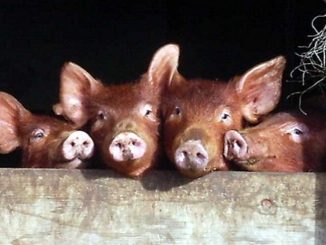ABSTARCT
Muscle foods are rich in their nutritional profile but they also carry certain negative aspects that include high levels of saturated fatty acids, cholesterol, sodium, high fat and caloric contents. So, consumers have been demanding quality meat as a source of quality diet to prevent nutrition related diseases, to improve their physical and mental well-being. Design and development of meat based functional foods by animal production practices and meat transformation systems adds to the value of muscle foods. Addition of omega 3 and PUFA to the feed impacts the fatty acid composition of meat and eggs. Vitamin E and Selenium content acts as antioxidant source, whereas amino acid content helps production of lean meat. Along with that, probiotics in these foods modulate intestinal flora and hence improves consumer health.
INTRODUCTION
“When diet is wrong, medicine is of no use, when diet is correct medicine is of no need”. The changing lifestyle in the current era has intended to change the dietary patterns of the consumers. A high rise in lifestyle diseases constitute high consumption of saturated fats, salt, refined carbohydrates, and low fruit and vegetables intake leading to major modifiable risk factors in relation to the development of non-communicable diseases: cardiovascular diseases (CVD), cancer, type 2 diabetes, obesity, osteoporosis, and dental diseases. As per WHO, out of all these, the chronic diseases contribute to approximately 60% of all deaths.

Muscle foods are major sources for many bioactive compounds like proteins and several micronutrients i.e. vitamin A, iron, zinc, conjugated linoleic acid and vitamin B. Along with their positive effects, muscle foods are also associated with nutrients and nutritional profiles that are often considered negative including high levels of saturated fatty acids, cholesterol, sodium and high fat and caloric contents. These major risk factors has lead the consumers to demand the quality meat as their quality diet, which not only aids to prevent the nutrition related diseases but also to improve their physical and mental well-being.
VALUE ADDITION IN MEAT PRODUCTS
According to, Functional Food Science in Europe (FUFOSE) : “A food that beneficially affects one or more target functions in the body beyond adequate nutritional effects in a way that is relevant to either an improved state of health and well-being and /or reduction of risk of disease”. In general, functional foods or value added food products maybe natural foods or foods in which a component has been added, removed or modified by technological or biological means.
Keeping the above in view, the livestock sector has already strategized and is working to produce such functional or designer food products of animal origin in the favor of consumers’ health.
Production of the functional/ value added meat and egg products comprehends two important ways;
1. Animal Production Practices: This practices are categorized into,
- Genetic selection and gene manipulation of the Livestock for gaining an improved and desired quality of the products.
- Provision of balanced nutrition to the Livestock and use of approved growth promoting agents.
2. Meat Transformation Systems: Meat transformation systems include,
- Reformulation process of the feed and fodder provided to the animals.
- Utilization of natural antioxidants, vitamins, mineral supplements and probiotics by incorporating them into the animal diet.
CLASSIFICATION OF FUNCTIONAL FOOD PRODUCTS
In consistent to the potential medical benefits through the properties of their ingredients, components which provide health promoting effects via functional foods are dietary fibre oligosaccharides, amino acids, peptides and proteins, glycosides, vitamins , lactic acid bacteria, minerals, polyunsaturated fatty acids and others (like phyto chemicals and antioxidants). Alteration of fatty acid profile of meat with omega 3 fatty acids, lowering of cholesterol and other compositional components such as choline, conjugated linoleic acid, lutein, selenium, and vitamins B, D, E and K has been in trend lately.
Two basic manners of value addition of products can be done in case of poultry meat production :
- Value addition before the product is produced i.e. before the slaughter or before oviposition under which functional / organic / designer eggs and meat products are produced. These products are usually free from residues of pesticides, drugs and other harmful chemicals.
- Value Addition after the slaughter or after the oviposition i.e. value addition after the product is produced (by carrying out proper management and nutritional manipulations simultaneously).
PROCESS OF VALUE ADDITION
Feeding of ω-3 fatty acids to the animals and birds or the enrichment of meat with ω-3 has a capability to fulfil the daily recommended intake requirement of the humans (Givens and Gibbs, 2006). A quantity of 100g of ω-3 fatty acids and selenium can meet 70–130% and 30–60% of the recommended daily intake for humans respectively (Grashorn, 2007).
CLA enrichment
Conjugated linoleic acid (CLA) is a group of positional and geometrical isomers of 18-carbon unsaturated fatty acids with two conjugated double bonds (unlike linoleic acid, which has a nonconjugated diene). CLAs have been shown to have antcarcinogenic, antiadipogenic, antidiabetic, anti-inflammatory and immune modulative properties which also help in regulating bone metabolism (Wahle et al., 2004; Bhattacharya et al., 2006, Naveen et al., 2014). Several studies have shown that concentrations of CLA in yolk lipids increased linearly as dietary CLA increased. Eggs produced by hens when fed with 5.0% CLA will contain 310 to 1000 mg of CLA per egg (Chamruspollert and Sell, 1999; Suksombat et al., 2006) which could provide a substantial amount of CLA in human foods to meet the proposed CLA requirement. CLA is formed predominantly in the rumen (Kandeepan and Biswas, 2006), because of which, it is naturally present in ruminant milk and flesh, especially in grass fed ruminants. Commercially produced CLA isomers have been injected into whole muscles and incorporated into meat products such as sausages to achieve enough levels of CLA to produce health benefits when consumed in smaller portions. CLA in frozen meat showed splitting of fibres and breaking and splitting of connective tissue which led to an increased tenderness and juiciness of the meat (Kandeepan, Biswas and Porteen,2006). ω-3 enrichment to poultry meat contributes about 75.0 mg ω-3 per person per day of dietary intake (Russell and Bürgin-Maunder, 2012).
ROLE OF ANTIOXIDANTS IN VALUE ADDITION OF MEAT
Meat quality gets deteriorated by lipid oxidation mainly. Oxidative reactions in meat affects the color, flavor, texture and nutritional value. Antioxidants are the compounds that inhibit or delay the oxidation of other molecules by inhibiting the initiation or propagation of oxidizing chain reactions. The high free radical scavenging abilities may provide a possible mechanism to explain the inhibition of lipid oxidation in cooked muscle food. These can be of natural as well as of synthetic origin. Consequently, search for natural additives, especially of plant origin, has notably increased in recent years, because they have greater application in food industry for increasing the consumer acceptability, palatability, stability and shelf life of food products which play advantageous role on the health aspect of the consumers as compared to that of synthetic antioxidants. Polyphenolic compounds, carotenoids, Vitamin A, Vitamin C, Vitamin E are the major types and sources of the natural anioxidants. Whereas, the most effective synthetic antioxidants are approved by Food and Drug Administration for addition to foods are BHA (Butylated hydroxyanisole), BHT (butylated hydroxy toluene), TVHQ (tertiary butylated hydroxy quinone) etc. Along with antioxidants like Vitamin E and Se, the enzymes like glutathione peroxidase, superoxide dismutase, catalaze constitute an integral part of antioxidant cellular enzyme system in omega-3 enriched products to reduce lipid peroxidation. The dietary supplementation of vitamin E is commonly used in commercial n-3 enriched products to mitigate the oxidation of n-3 FA, thereby preventing the formation of undesirable fishy flavor and warmed over flavor in refrigerated cooked and raw meat (Fraeye et al., 2012). Besides these, other anti-oxidants as chemicals and herbs may be added, to prevent oxidative rancidity.
Selenium and Vit E enrichment
Selenium contains an essential antioxidant seleno-enzyme Glutathione peroxidase that efficiently protects the meat and meat products against lipid peroxidation. Meat and meat products including edible offals contain cholesterol content generally less than 70 mg/100 g of meat. Due to oxidation of cholesterol (COP) certain cytotoxic, mutagenic and carcinogenic compounds are produced that triggers atherosclerosis. Thus, Se supplementation beneficially reduces the cholesterol content in meat. Selenium also tends to inhibit metmyoglobin formation, therefore maintaining the color stability. Several studies have also shown that supplementation with organic Se reduces drip loss in meat. The antioxidant content in Se effects the cellular membranes and tissue structures in poultry because of which a less exudative loss is observed. Organic Se (Selplex) at 0.1-0.3ppm can be added as anti-oxidants to the poultry diet (Surai et al., 2010). Supplementation of Vit-E to the animals @ 0.5g/kg for 126 days doubly increases the display life of meat (Kandeepan et al., 2009). In several broiler performance trials, organic Se supplementation showed a positive effect on weight gain and FCR compared to controls (Spring, 2008). Vitamin E was has also been reported to reduce the lipid oxidation (malondialdehyde concentration) in breast and thigh meats during refrigerated storage (Goñi et al., 2007).
Other Advantages of antioxidant enrichment in meat
They have the capability to prevent ‘fishy taint’ of the product. These could be a good source of antioxidants in human diet. And prevent destruction of fat-soluble vitamins and natural fat-soluble pigments.
Lean meat production
The present health conscious consumers prefer meat with high protein, low fat and low cholesterol. As a matter of fact, fats of poultry meat are not the fats but are oils; because their saturated fatty acid content is only one third of the total fatty acid content, nearly 45% is cardiac friendly monounsaturated fatty acids (MUFA) and the remaining are polyunsaturated fatty acids (PUFA). Manipulation in animal diet may help in production of meat with low carcass fat i.e. <5% and cholesterol at the level of <50mg/100g. Nevertheless, such lean meat leads to higher production cost because of lower body weight and poor feed efficiency. Chromium added in feed decreased the fat content of the poultry meat (Toghyani et al., 2012). As studied by Amatya et al., (2004), organic Cr increased the pectoral muscle weight that led to less fat and cholesterol content in the meat. 0.2 mg/kg of Cr supplement helped increase protein level simultaneously reducing fat deposition in meat . Probiotics at a level 100 mg/kg of diet improved moisture, protein, ash and decreased fat content in leg and breast meat of chicken (Khaksefidi and Rahimi, 2005). The ratio of calorie : protein ratio if maintained either by decreasing the energy level or increasing the protein level also aids in producing lean meat. Broiler diet supplemented with fish oil at the rate of > 2% lowers down the cholesterol levels and abdominal fat pad thickness; but with an undesirable‘fishy taint’ to the meat. An increase in the lysine level in the pre-starter diets and methionine level in the finisher diets will yield lean breast meat in broilers.
Dietary fibres in meat products
Dietary fibre consists of edible plant cells -cellulose, hemicellulose, lignin, pectins and a variety of gums and mucilages.
- An adequate fibre diet has a variety of specific healthful benefits, the major one of which is optimizing gastrointestinal physiological function.
- Fibre is suitable in meat products and has previously been used in meat emulsion products because it retains water, decreasing cooking losses without affecting flavour of cooked product.
- Sugarbeet, wheat, oat and pea fibre have been used, mainly in cooked meat products.
- The most important property of fibre from a technological standpoint is that of ability to bind water.
- The use of fibres can assist the restructuring of products and in most meat products, the uses of these fibres can help achieve the right texture in restructuring of previously ground muscle.
Probiotics for value addition
A probiotic is a culture of living microorganisms which are beneficial to the host health when ingested at certain levels. Probiotics prevent the growth of harmful bacteria through competitive exclusion while generating organic acids and antimicrobial compounds in the colon (Salminen et al., 1996). These are mainly lactic acid bacteria or bifidobacteria. Dry sausages are mainly incorporated with probiotic bacteria mainly for fermentation process. A particular flavor is produced through lactic acids, acetic acids and volatiles that are created due to carbohydrate fermentation (Molly, Demeyer, Civera, & Verplaetse, 1996). Probiotics carry a specific mechanism of action, they adhere to intestinal cells and get colonized inside the gut. They work antagonistically against the pathogenic bacteria by producing antimicrobials. Thus, carrying immune modulating properties for the consumer (Brassart & Schiffrin, 2000). Incorporation of lactic acid bacteria as probiotic into meat products was first carried out by Germany and Japan (Arihara, 2006). The meat products incorporated with probiotics are reported to improve the human health by improving the quality of the meat products without causing significant differences in sensory properties. According to Jahreis et al. (2002), probiotic sausage increased the antibodies against oxidized low density lipoprotein without any significant effects on serum concentration of various cholesterol fractions and triglycerides in human. After consuming probiotic sausages, CD4 (T-helper)-lymphocytes increased and the expression of CD54 (ICAM-1) on lymphocytes decreased in people. Probiotic bacteria and probiotic products are proved to have various functions including modulation of intestinal flora, prevention of diarrhoea, improvement of constipation, prevention and treatment of food allergies, reduction of cancer risk, lowering plasma cholesterol level and lowering faecal enzyme activities (Agrawal, 2005, Arihara, 2006, Stanton et al., 2003).
Examples of microbial strains that are commercially used as probiotics:
| Microbial strain | Trade Name | Application |
| 1. Lactobacilli | ||
| Lactobacillus casei Shirota (YIT 9029) | Yakult | Gut health, digestive system, natural defense |
| Lactobacillus rhamnosus GG(ATCC 53103) | Gefilus, Vifit | Gastro-intestinal health, immune response |
| Lactobacillus casei Imunitass (DN-114 001) | Actimel | Immune response |
| Lactobacillus plantarum 299v | ProViva | Digestive system |
| Lactobacillus johnsonii La1(NCC 533) | LC1 | Gut health, natural defense |
| 2. Bifidobacteria | ||
| Bifidobacterium animalis subsp. Lactis | Activia | Gut transit |
| Bifidobacterium breve Yakult | Bifiene | Digestive system/gut microbiota |
| 3. Lactic acid bacteria mixtures | ||
| VSL#3 (mixture of eight strains) | VSL#3(Powder | Biotherapeutic agent (irritable bowel syndrome, bowel diseases) |
| 4. Yeasts | ||
| Saccharomyces boulardii | Enterol (pills) | Biotherapeutic agent (diarrhea, Clostridium) |
CONCLUSIONS
- Nutritional technology is a mechanism to improve meat quality.
- An adequate nutrition enables fast weight gains and strong muscling.
- A determining factor for high quality meat, appearance, flavour, odour, tenderness and consumer acceptance.
- It has positive effect on fat content, fatty acids, cholesterol levels, vitamins and trace minerals, targeting products for specific category of consumers.
- Thus, animal diet greatly contributes for enhancing the meat production and quality.







Quite informative. Thank you for sharing such artical.